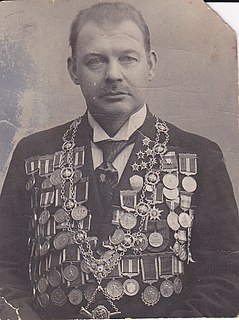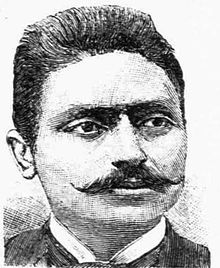
Shooting sports is a group of competitive and recreational sporting activities involving proficiency tests of accuracy, precision and speed in shooting — the art of using ranged firearms, mainly referring to man-portable guns and bows/crossbows.

The International Shooting Sport Federation recognizes several shooting events, some of which have Olympic status. They are divided into four disciplines: rifle, pistol, shotgun and running target.
Holger Louis Nielsen was a Danish fencer, sport shooter, and athlete. He competed at the 1896 Summer Olympics in Athens. He is probably best known for drawing up the first modern set of rules for the game of handball.

Pantelis Karasevdas was a Greek sport shooter. He was a member of Panachaikos Gymnastikos Syllogos, that merged in 1923 with Gymnastiki Etaireia Patron to become Panachaiki Gymnastiki Enosi. Karasevdas competed at the 1896 Summer Olympics in Athens, where he won a gold medal for the host country.

Anastasios Metaxas was a Greek architect and shooter.

Georgios Orphanidis was a Greek sports shooter. He competed at the 1896 Summer Olympics in Athens and at the 1908 Summer Olympics in London. He also competed at the 1906 Intercalated Games.

The 300 m rifle three positions event was one of five free rifle events of the competitions in the Shooting at the 1900 Summer Olympics events in Paris. They were held from August 3 to August 5, 1900. 30 shooters from 6 nations competed, with five shooters per team. Medals were given for individual high scores in each of the three positions, overall individual high scores, and the scores of the five shooters were summed to give a team score. The three positions event was won by Emil Kellenberger of Switzerland. Anders Peter Nielsen of Denmark took silver, while Ole Østmo of Norway and Paul Van Asbroeck of Belgium tied for bronze.

The men's 300 metre free rifle was one of the five sport shooting events on the Shooting at the 1896 Summer Olympics programme. The second rifle event and last of the shooting events, the free rifle was begun on 11 April. Each marksman fired 40 shots, in four strings of ten. 25 men entered the event, though only 20 actually competed. They represented three nations. Frangoudis led after the first day, but when the event was continued on 12 April, Orphanidis took the lead and held on to win first place. He hit the target 37 times.

The men's 25 metre military pistol was one of the five sport shooting events on the 1896 Summer Olympics shooting programme. 16 competitors from four nations entered the military pistol match, held on 10 April. Each shot thirty rounds in five strings of six at a target 25 metres away. The winner, John Paine of the United States, hit the target 25 times. His brother, Sumner Paine, hit the target 23 times. They used American-made military Colt revolvers.

The 25 metre muzzle-loading pistol was one of the five sport shooting events on the 1896 Summer Olympics shooting programme. The armament of the American Paine brothers was disqualified because of not being "of the usual calibre" for the event. With the Paine brothers declining the offer of the Greek shooters to use their pistols, only four shooters entered the fourth shooting event. Three nations were represented. Each shooter fired five strings of six shots at a target 25 metres distant. The competition was held on 11 April and resulted in the top two places going to the Greek marksmen. Nielsen took third place and Merlin did not finish.

The men's "30 metre individual competition with free revolver" was one of the five sport shooting events on the 1896 Summer Olympics shooting program. Six competitors entered the pistol event on 11 April. Having won the 25 metre military pistol event, John Paine then withdrew from the 30 metre free pistol event, citing his desire to not embarrass his Greek hosts. He also said he had an agreement with his brother that whoever won the first event between them would drop out the next event. The competitors each shot five strings of six shots. Sumner Paine won the event.

The men's 300 m rifle three positions was one of 15 events on the shooting at the 1908 Summer Olympics programme. The competition was held on Saturday, 11 July 1908. Each nation could enter up to 12 shooters. Fifty-one sport shooters from ten nations competed. The event was won by Albert Helgerud of Norway, the nation's first victory in the event. Norway also won bronze, with Ole Sæther finishing third. Between the two Norwegians was Harry Simon, taking silver in the United States' debut.

The men's team free rifle at 300 metres was one of 15 events on the shooting at the 1908 Summer Olympics programme. The competition was held on Thursday, 9 July 1908 and was extended after sunset to Friday, 10 July 1908 — it was the first shooting event of the Games. Fifty-four sport shooters from nine nations competed. The event was won by the team from Norway, improving on their second-place finish in 1900. Sweden made its debut in the event, taking silver. France repeated as bronze medalists.

The men's 300 m rifle three positions was a shooting sports event held as part of the shooting at the 1912 Summer Olympics programme. It was the third appearance of the event, which had been introduced in 1900. The competition was held on Tuesday, 2 July 1912. Eighty-four sport shooters from nine nations competed. The event was won by Paul Colas of France, the nation's first medal in the event. Denmark took the silver and bronze medals, as Lars Jørgen Madsen finished second and Niels Larsen placed third.

The men's 300 metre free rifle standing event was one of five free rifle events of the competitions in the Shooting at the 1900 Summer Olympics events in Paris. It was held from August 3 to August 5, 1900. 30 shooters from 6 nations competed, with five shooters per team. Medals were given for individual high scores in each of the three positions, overall individual high scores, and the scores of the five shooters were summed to give a team score. The standing position was won by Lars Jørgen Madsen of Denmark, with Ole Østmo of Norway taking silver and Charles Paumier of Belgium bronze.

The men's 300 metre free rifle kneeling event was one of five free rifle events in shooting at the 1900 Summer Olympics in Paris. It was an individual kneeling position event, and competitors' scores also counted towards the individual and team three-position events. It was held from 3 to 5 August. There were 30 competitors from 6 nations, with each nation having a team of 5 shooters. Medals were given for individual high scores in each of the three positions, overall individual high scores, and the scores of the five shooters were summed to give a team score. The kneeling position was won by Konrad Stäheli of Switzerland, with Emil Kellenberger of Switzerland and Anders Peter Nielsen of Denmark tying for silver.

The men's 300 metre free rifle prone event was one of five free rifle events of the competitions in the Shooting at the 1900 Summer Olympics events in Paris. It was held from August 3 to August 5, 1900. 30 shooters from 6 nations competed, with five shooters per team. Medals were given for individual high scores in each of the three positions, overall individual high scores, and the scores of the five shooters were summed to give a team score. Achille Paroche of France won the gold medal in the prone event, with Anders Peter Nielsen of Denmark taking silver and Ole Østmo bronze.

The men's 300 metre team free rifle event was one of five free rifle events of the competitions in the Shooting at the 1900 Summer Olympics events in Paris. It was held from August 3 to August 5, 1900. 30 shooters from 6 nations competed, with five shooters per team. Medals were given for individual high scores in each of the three positions, overall individual high scores, and the scores of the five shooters were summed to give a team score. The top scoring team was Switzerland, led by individual champion Emil Kellenberger. Silver went to Norway, while France took bronze.

The men's 300 m rifle three positions was a shooting sports event held as part of the Shooting at the 1952 Summer Olympics programme. It was the sixth appearance of the event at an Olympic Games. The competition was held on 27 July 1952, with 32 shooters from 18 nations competing. Each nation was limited to two shooters. The event was won by Anatoli Bogdanov with Lev Vainshtein in third, as the Soviet Union took both gold and bronze in its debut. Between the Soviets was Robert Bürchler of Switzerland, earning silver.

The men's 300 m rifle three positions was a shooting sports event held as part of the Shooting at the 1956 Summer Olympics programme. It was the seventh appearance of the event at an Olympic Games. The competition was held on 1 December 1956, with 20 shooters from 14 nations competing. Nations had been limited to two shooters each since the 1952 Games. The event was won by Vasily Borisov of the Soviet Union, the nation's second consecutive victory in two appearances. The Soviets finished 1–2, with Allan Erdman taking silver. Vilho Ylönen of Finland earned the bronze.












